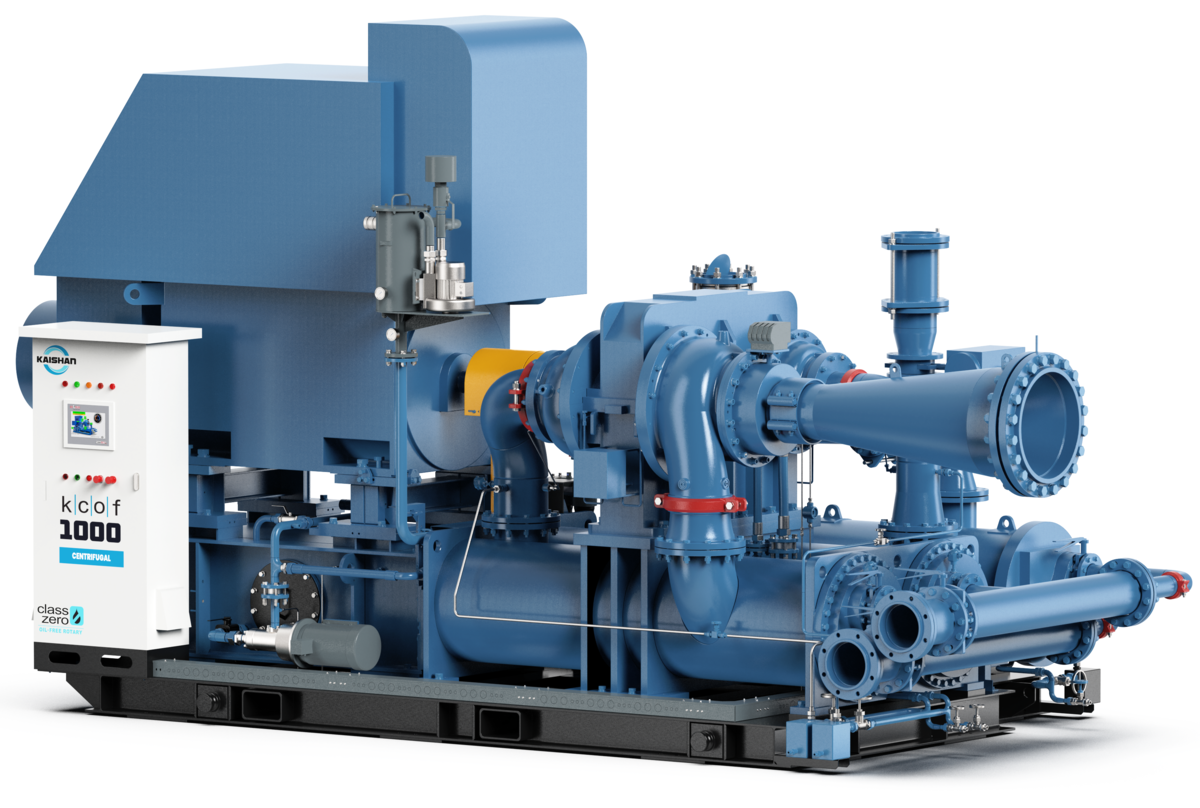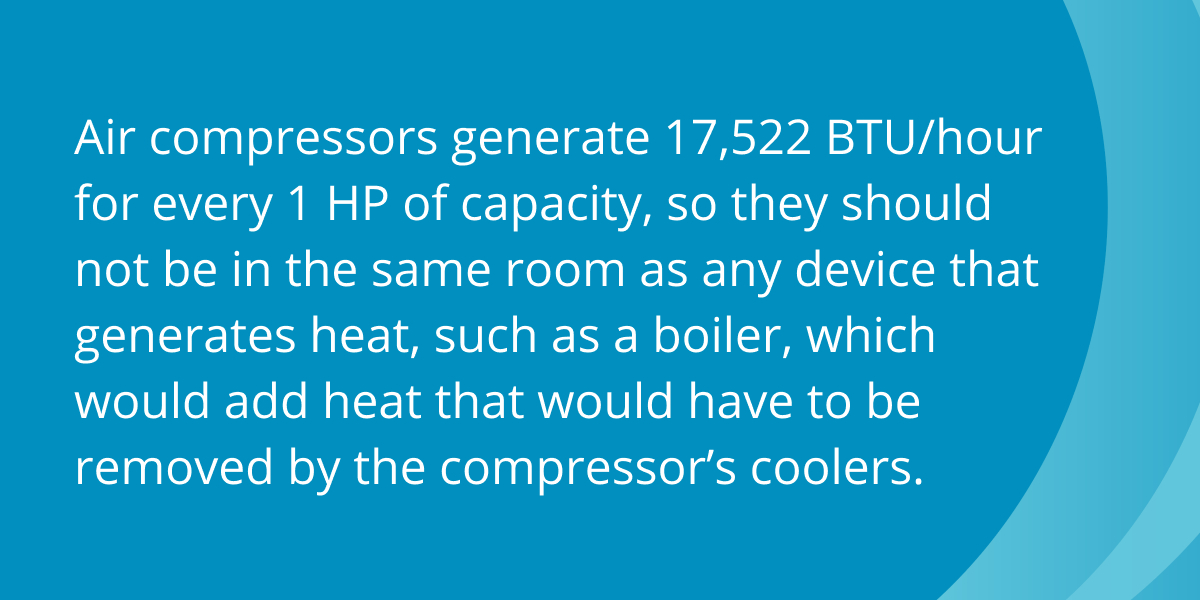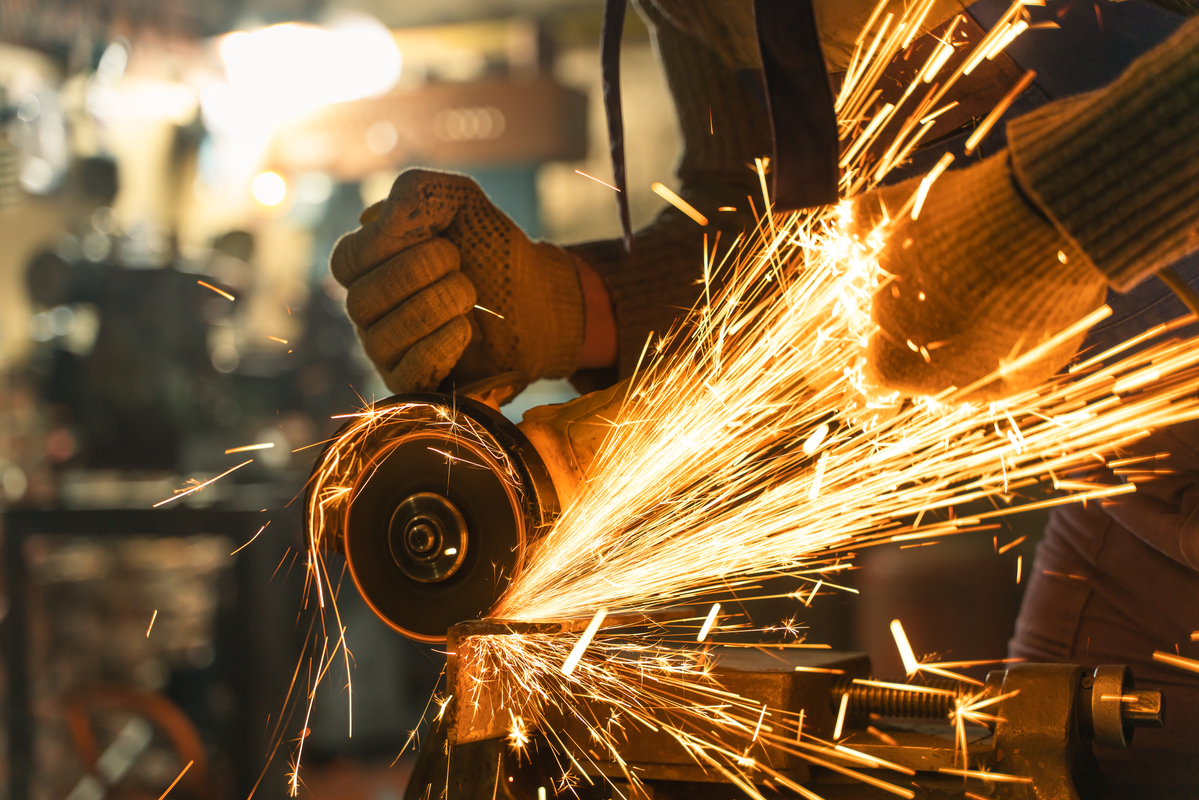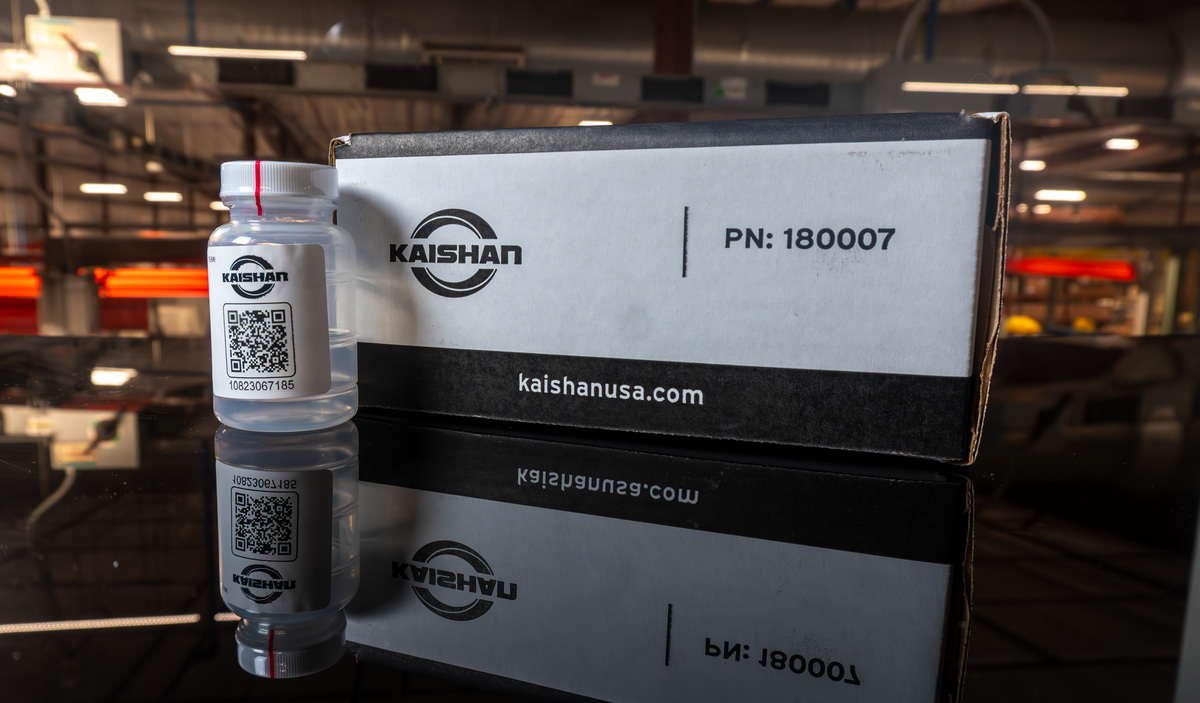
The Role Rotary Screw Air Compressors Play in a Disaster
May 7, 2025
End-of-Life Decisions for Rotary Screw Air Compressors
May 21, 2025Lean Manufacturing & Kaizen in Compressed Air Systems
Kaishan USA | May 14, 2025| Uncategorized

Workers use a kanban board to prioritize tasks as part of a lean manufacturing system.
Since 1988, when former Waymo CEO John Krafchik coined the term to capture the essence of the Toyota production system, U.S. companies have embraced lean manufacturing.
Terms like kaizen and continuous improvement have become commonplace in the American workplace. And U.S. companies are the better for it, saving billions by cutting waste and improving productivity.
While compressed air is a relatively inefficient way to transfer power, it is the essence of lean. Done properly, compressed air is only used where needed, where its unique advantages in safety, ergonomics and resistance to harsh environments make air tools the only choice for certain applications. For a complete list of compressed air’s many advantages, see our blog post, “Air-powered Tools: The Seven Benefits and Uses of Pneumatic Tools.”
It is the right technology for applications like mining, where sparks can be fatal. In wet applications like welding or sanding underwater. Or in continuous-use applications.

Compressed air is the right tool for applications such as welding underwater.
The operative phrase above is “done properly.” It means that it is only used when needed and in accordance with the core principles of lean listed below.
The first principle is to use the right compressed air tool for the job.
The Right Tool
Compressed air technology presents lean manufacturing practitioners with three main types of compressors to power their compressed air systems:
- Centrifugal compressors, such as Kaishan’s KCOF centrifugal air compressor, are most efficient in applications that need large amounts of continuous flow. Usually more than 600 HP.

Centrifugal compressors, such as Kaishan’s KCOF centrifugal air compressor, are most efficient in applications that need large amounts of flow.
- Reciprocating compressors are generally the most cost-effective choice for smaller applications. Recips are good for intermittent use and not a constant operation/demand profile.
- Rotary screw compressors are used in most industrial and commercial facilities today because of their compressed air efficiency, long life and low cost of ownership.
The right choice will allow you to optimize energy consumption, maintenance costs and downtime, helping build system reliability and long-term return on investment. As mentioned, most facilities find rotary screw air compressors to be the machines of choice, because of their reliability, low cost of ownership and their ability to run 24/7/365. Centrifugals work well in high-volume locations.
For more on the pros and cons of different compressor types, read our blog post, “Which Type of Air Compressor Is Best for Your Application?” And for the specific advantages of rotary screw air compressors, see “The Top 20 Benefits of Rotary Screw Compressors for Industrial Use.”
Add Variable Speed Drive, But Only If Appropriate
The application of variable-speed and variable-frequency drives to rotary screw air compressors has enabled many companies to save significant amounts of energy. VSD compressors can also earn rebates, allow soft starts and offer better control of your compressed air system. They are also an energy-efficient way to address rapid cycling.
VSDs and VFDs deliver the greatest benefits when you have significant fluctuation in demand—variations between shifts or at different times of the year. Because of their internal energy losses, VSDs are not recommended at capacities below 20% or above 80% of the rated compressor CFM output. and you’ll want to keep an oil-free unit with a VSD above 60%.
For more on the pros and cons of VSDs, see our blog post, “How Variable-Speed Drive Rotary Screw Air Compressors Save You Money.”
The Right Size
Sizing is one of the most critical decisions you’ll make about your compressors, even more crucial than the type or brand. The most severe problems, in fact, almost always start with mistakes in sizing or application.

Over the years, we’ve seen far too many facilities oversize their compressors. They want to buy a compressor with “room to grow” or plan for future expansion. In lean terms, oversizing a compressor is another form of waste, a serious mistake that can lead to problems right from the start. It may seem counter-intuitive, but purchasing “too much” compressor is as bad as buying “not enough.”
In addition to building in inefficiency, oversizing could cause your new compressor to start and stop too often, leading to rapid cycling. That, in turn, requires more frequent maintenance and can lead to oil carryover and overheating. In the long term, it increases wear and tear on critical internal parts and shortens a compressor’s lifespan. It’s something you want to avoid. Your local compressed air professional is a great resource to perform an audit.
For more on the intricacies of sizing, read our post, “Everything You Need To Know About Sizing Industrial Air Compressors for Manufacturing.” Or download our white paper, “Demystifying Air Compressor Sizing.”
Where you locate a compressor could also have a major impact on its operation.
The Right Location
In more moderate climates, like the southeastern and southwestern states of the United States, you can locate an air compressor outside (with at least three walls and a roof). Putting it outside is a great way to reduce noise and ensure a supply of fresh, clean, cool air.
You’ll want to house it in a three-sided shed with a roof to protect it from the elements, temperature extremes, prevailing winds and direct sunlight. If your air compressor has a variable-speed drive, you’ll want to take special care to protect it.
However, indoor locations are preferable. In a perfect world, your air compressor would be installed in a clean, dust-free, dry and oil-free area. The area would be relatively cool and adequately ventilated. There would be good lighting and enough space to allow maintenance access—preferably four feet of open space around the unit.
A few other lean installation tips:
- Temperature. Because air compressors run hot, they should not be in the same room as any device that generates heat, such as a boiler, which would add heat that would have to be removed by the compressor’s coolers. After all, compressors alone generate 17,522 BTU/hour for every 1 HP. Find out more about the importance of heat removal in ensuring your compressor’s reliability and longevity in our blog post, “Air Compressor Cooling.”

- Central location. Locate the unit centrally, as close as possible to the tools it’s intended to service. That will reduce the amount of piping required, thereby avoiding the leaks and pressure drops that sometimes occur in long piping runs.
- Maintenance access. Place your compressor at least four feet away from walls or other equipment to allow for maintenance and service.
For more on the ideal location for a compressor, see our blog post, “How To Design And Prepare For an Industrial Air Compressor Installation.”
The next lean principle is the way you have your compressed air system configured.
The Right Configuration
While you may think that lean principles would encourage facilities to rely on a single compressor to handle all your compressed air needs, we often encourage customers to adopt a multiple-compressor system, including:
- A base load compressor to meet your system’s minimum compressed air load
- A trim compressor to handle fluctuations in demand above the base unit
- A backup compressor on standby if a base or trim unit goes offline
A multi-compressor configuration can virtually eliminate unplanned downtime, simplify maintenance and reduce electricity usage—all lean goals. You can also sequence two units to wear the consumables and hard items evenly across the two units, so both have similar load hours on them.
For more on compressed air system design using a multi-compressor configuration, read our blog post, “How Energy-Efficient Air Compressors Can Reduce Your Carbon Footprint.”
Some customers avoid using a trim unit by relying on a VSD air compressor to cover the variations in load. We strongly encourage these facilities to build in at least some form of backup. For example, adding a quick connection to a portable compressor, such as Kaishan’s KRSR portable electric rotary screw air compressor, allows for maintenance or emergency service if their compressor goes down.
Operating your compressor as efficiently as possible is another great application of the lean philosophy.
The Right Operation
A crucial part of operating your compressed air system is setting the header pressure as low as possible.
Start by identifying the high-pressure applications. The Compressed Air Challenge, a group of industry manufacturers, government agencies and utilities, even recommends serving high-pressure or remote applications with a separate, dedicated compressor.

Applications like angle grinding may require higher pressure than other tools in your compressed air system. As a result, they may require a separate, dedicated compressor.
Then, work to scale back the pressure to your other end uses. Compressed Air Best Practices notes that you should reduce the pressure band—the gap between the load and unload pressure—as low as possible without affecting end-use applications. The article suggests reducing the pressure by 1 PSIG daily until an end user reports a problem.

Remember, the rule of thumb: for every 2 PSIG increase in pressure, energy consumption goes up by 1%. So if your plant needs 100 PSIG and you're compressing up to 130, that’s a lot of wasted energy;
For a complete discussion of the details of setting your system pressure, visit our blog post, “How Lowering the Pressure Band of Your Compressed Air System Can Save You Money.”
Maintaining your compressed air system is another point that almost screams lean.
The Right Maintenance
Properly maintaining your rotary screw air compressor can result in many benefits, from cutting downtime and reducing energy costs to prolonging equipment life and improving safety. Some specifics include the following:
- Uptime. According to a recent survey by Industry Week in collaboration with Emerson, downtime costs industrial manufacturers $50 billion a year globally. Other estimates indicate unplanned downtime costs manufacturing enterprises as much as $9,000 a minute. By performing regular maintenance, you’ll keep unplanned downtime to a minimum.
- Energy efficiency. A properly maintained system will deliver significant energy savings. According to various estimates, your compressor’s lifetime energy consumption will be significantly higher than its initial cost. For more on energy efficiency, see our blog post, “Reduce Energy Costs: Four Tips for Plant Managers.”
- Equipment life. A well-maintained compressor will have a long working life and could impact the longevity of the equipment it serves. And avoid catastrophic failures that could result in significant repair and replacement costs.
- Safety. Properly maintaining rotary screw air compressors will reduce the heat, vibration, pollution and noise impact on your people. And they are less likely to have serious failures that injure workers. For more on safety, see our blog post, “Eight Ways to Improve Air Compressor Safety.”
- Air quality. A well-maintained system will provide higher-quality air, improving the performance and longevity of your downstream tools and applications.
That means paying attention to the basics, such as checking oil and filters at recommended intervals. Doing regular checks during startup. Drawing an oil sample in compliance with warranty requirements. Regularly monitoring compressor data. And engaging your team members in continuous improvement efforts—a classic lean tactic we often neglect.

Most air compressor manufacturers, including Kaishan USA, require regular oil sampling to maintain warranty eligibility.
Those approaches and more make up a proactive maintenance strategy that can reduce maintenance costs significantly over the lifetime of your equipment.
And what can be more lean than preventing leaks? Some compressed air systems lose as much as 30-50% their volume to compressed air leaks, according to Compressed Air Best Practices. That’s almost the definition of waste.

This Fluke ii915 Precision Acoustic Imager not only pinpoints the sources of leaks but also estimates the potential savings you’ll realize by fixing them. That’s especially important if you need to rent a lift to reach a 20-foot-high leak site.
For a comprehensive air compressor maintenance checklist, download our white paper, “Air Compressor Maintenance: Ultimate Guide and Checklist.”
If you need lean manufacturing help in any aspect of compressed air, you don’t have far to go.
Lean In with Local Support
Any facility can benefit from embracing the core elements of lean—eliminating waste, improving compressed air efficiency and cutting costs.
The good news is that there’s a compressed air professional near you who can help in all of those areas. We work with a nationwide network of independent distributors, who are uniquely qualified to help.
We partner with these independent, local companies because it's the best way to serve you. They have factory-trained air compression experts who can service your air compressor system without a problem. They can also offer expert guidance, faster response times and personalized support tailored to your needs. Their role is to ensure you get the right system, reliable service and quick access to parts when you need them most.
When you buy through Kaishan, you're getting more than a product—you're getting a local partner who cares about your business and wants to see it succeed.
Key Takeaways
Applying the key elements of lean manufacturing to compressed air systems requires:
- The right tool
- The right size
- The right location
- The right configuration
- The right operation
- The right maintenance
Let Us Help
Achieving the benefits of lean manufacturing with your rotary screw air compressor is critical to the operation of your compressed air system and all the processes that rely on that system. If you need help eliminating waste, boosting compressed air efficiency or cutting costs in your compressed air system, get in touch with the experts at Kaishan. Contact us today.
Listen to the Podcast Version
Lean Thinking and Compressed Air: The Real Connection
Welcome back, everyone! Hard to believe that we're now TWENTY episodes in with the Big Dog podcast. Let's keep this rollin'. We're thrilled you could join us!Alright, let's talk about lean manufacturing. You know, since the 80s, this whole idea really flipped U.S. industries on their heads. Billions—literally billions—were saved just by cutting waste. And you know what? Compressed air, as inefficient as it can be, somehow became a huge part of this lean mindset. It's like, you use it where you gotta, right?
Right. And it's interesting, isn't it? Compressed air isn't just about pushing buttons and making things run faster. It’s kind of a... strategic choice. Specific situations where its safety, ergonomic benefits, or environmental resistance make it irreplaceable. But only when it’s used deliberately, with intention.
Exactly, intention—that’s everything. I remember this one time walking onto a shop floor. We’d just rolled out lean, and suddenly, it was like a whole new world. No more blowing off machines or, you know, just letting hoses run because someone ‘didn’t feel like turning it off.’ Every single hose? Had a reason for being there.
Oh, I love that. It's such a clear picture of what lean thinking does—fewer resources wasted, more focus on what really matters. But I wonder how teams adjust to that shift at first? You know, were they on board immediately?
Ha, no. Not right away. I mean, we're we’re talking serious mindset changes here. But once they saw the results—productivity up, utility costs down—it just clicked.
See, that’s inspiring. Because what you’re describing isn’t just about saving a few bucks. It’s a systems-level change that impacts everything downstream. And compressed air—used where it really shines—kinda becomes this hidden powerhouse in that whole puzzle.
Choosing the Right Compressor and Getting the Sizing Right
So, building on that idea of using compressed air where it really shines, let’s talk about the actual compressors. They’re not a one-size-fits-all tool—different systems work for different jobs. You’ve got centrifugal for the big tasks, reciprocating for smaller setups, and then rotary screws, which dominate most industrial setups today.Rotary screws, yep. They're the go-to for a reason. Twenty-four-seven reliability, efficient as hell, and they just don’t quit. But you can’t just pick one blindly. It’s all about application.
Right, like centrifugal compressors. They’re great if you’re dealing with high-volume, continuous flow—you know, 600 horsepower or more. But anything less and you're, honestly, just burning energy unnecessarily.
And the reciprocating ones? They’re not too bad for intermittent stuff. Like, stop-and-go demand, not constant runtime. But they’re not what you're using when your plant’s running steady 24/7. You need scale for that.
Exactly! And then there’s oversizing... Oh my gosh, the horror stories. I remember visiting this plant, and they had this absolute monster of a compressor—
The giant chewing up kilowatts every second?
Yes! It would cycle on and off all day long. Just—boom, idle, boom—all while guzzling energy and wearing itself out way faster than necessary. All because someone thought ‘bigger is better.’
Classic mistake. Buying "room to grow" without doing a proper load audit. People don’t realize, every minute a machine is short-cycling like that, it’s killing its own lifespan. Rapid cycling is brutal—not to mention the heat, oil carryover, and downtime it racks up.
But when they finally brought in a right-sized rotary screw compressor? Total game-changer. It kept up with demand flawlessly without constantly starting and stopping. And the energy bill? Night and day difference.
Right. And audits—those aren’t optional anymore. You’ve gotta understand your CFM demands, your peaks vs. lulls. That’s where compressed air audits really pay off, finding the sweet spot instead of overshooting or undershooting.
System Setup, Smarter Operation, and Maintenance That Pays Off
Building on that idea of efficiency and precision, let’s talk about multi-compressor setups. They’re game changers. You’ve got your base load, trim unit, and backup for emergencies. Why roll the dice on downtime when you can build reliability into the system upfront?Exactly. And it’s not just reliability. Splitting the load like that can actually save energy. By balancing usage, you’re not overworking any one machine. And if you add a variable-speed drive? Suddenly you’re looking at efficiency gains that are hard to ignore, especially with fluctuating demand.
Oh yeah, but let’s be real. Not every job calls for VSDs. If your demand’s too steady—or too low—you’re just throwing money away on internal energy losses. Gotta audit, dig into the numbers. Make it make sense, right?
Right. And speaking of audits, I can’t stress enough how crucial regular maintenance is. You wouldn’t believe how many systems lose 30 to 50% of their air to leaks. It’s almost criminal how much energy that wastes.
It’s like leaving money on the table—literally. And leaks? They don’t fix themselves. Get the tools, like an acoustic imager, pinpoint the problem, and lock it down.
Totally. Regular checks go beyond just repairs, though. When you keep oil clean, filters fresh, and pressure optimized? You’re multiplying the lifespan of your equipment—and keeping downtime to a minimum. It all connects back to lean thinking.
Yeah, but sometimes maintaining that system takes a village. That’s where local distributors come in clutch. They know your setup, they’ve got the parts, and they can get to you fast when things go sideways.
Absolutely. I think of that case last summer—a plant in Texas lost a compressor during a heatwave. The local distributor showed up with a portable backup the same day. Disaster averted, all because they had that connection.
That’s the kind of support every site needs. You can’t put a price on fast response times or a team that knows your system inside out. It’s lean, it’s smart, and it works.
And that’s the takeaway for today—whether it’s smarter setups, VSDs, or maintenance, lean principles make compressed air systems a lot more than just a utility. They’re strategic assets.
Couldn’t have said it better myself. And with that, we’re wrapping up this episode of The Big Dog Podcast. As always, stay efficient, stay smart, and we’ll see you next time.
Bye, everyone!
Random stat or
customer quote
textXXtext
text

